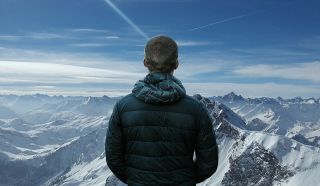Spirituality
The Value of Looking at Long-Distance Views
Personal Perspective: The benefits of taking in big vistas and wide open spaces.
Updated November 5, 2023 Reviewed by Davia Sills
Key points
- “The health of the eye demands a horizon,” Emerson said. So does the health of the soul.
- Big vistas offer a sense of expansiveness, stimulating contemplations grander than the everyday.
- Long views help satisfy the spiritual urge to feel part of something bigger than one's self.

When he was in his 20s, travel writer Bruce Chatwin was an art expert at Sotheby’s, a job he found increasingly distasteful. One morning, he woke up blind. The doctor said there was nothing organically wrong with him. “You’ve been looking too closely at pictures,” he said. “Why don’t you swap them for some long horizons.”
So Chatwin went to Africa. His eyes recovered by the time he got to the airport.
I recently returned from a month and 4,000 miles of van-camping through the Southwest, and among the benedictions of that journey was the profusion of long horizons and enormous vistas. As Emerson once said, “The health of the eye demands a horizon,” and I think the same goes for the soul. Something to counter nearsightedness and the narrow ruts of immediacy. Something that takes you out of the house, out of town, out from behind the roles and responsibilities—the four walls—of daily life, and lets you stand before big vistas, wide open spaces, long views, horizon lines, and a star-stuffed night sky that reminds you that you live in a universe because, for a change, you can actually see it.
To say nothing of auditory spaciousness, because among the endowments of especially desert wilderness is vast stillness and, when sufficiently removed from the din of humanity, vast silence in which the larger voices that want to speak through you are easier to hear than in the cities with all their aural and moral cacophony.
These conditions are a stimulus to contemplations grander than the everyday, to perspectives that we Earth-bound and time-bound often crave. It’s a look at the bigger picture, which is always getting bigger because the universe is always expanding. And studies have shown that broadening your visual field increases your chances of insight when problem-solving. When you see more broadly, you think more broadly.
You also calm your nervous system. According to Andrew Huberman, a neuroscientist at Stanford, “panoramic vision” is associated with calmness and the reduction of stress, as opposed to “focal vision,” which, granted, gets things done but is so culturally favored that it tends to reward focused attention to the point that we sometimes trade health and well-being for productivity.
But there are a handful of ways to gently downshift your close-up, laser-focused attention and reap the benefits of panoramic vision: Occasionally look up from your work toward a window; take a spin around the block; gaze at a horizon or broad vista. We didn’t evolve to maintain hyper-focus for long stretches of time but to toggle back and forth between that and panoramic focus, during which our gaze goes soft and wide.
(We also evolved to prefer the overlooking vantage point, which is a subset of panoramic vision and which many evolutionary psychologists believe provided our ancestors with survival advantages. From a distance or height, we were more likely to spy game, predators, or enemies.)
But in contemporary life, our focus and our orbits can easily narrow down over time to the use of a few beaten paths, a handful of faculties, the cadaverous light of the computer and television, the company of the same people and the same ideas, and a small wedge of experience that excludes whole worlds of discovery and inspiration, while the larger life that’s always out there accuses us of mere contentment.
But there’s another part of us, very different from the indoor self, that’s always scratching at the back door, wanting out, wanting a break from it all. From looking at the world through windows and the bars on windows, from buildings that block the sun, city lights that block the stars, routines that block spontaneity, and roles and rituals we continually reenact that may long ago have emptied of their meaning.
The principle task of civilization, Freud once remarked, is to defend us against nature, “but the human spirit hates to be cooped up and is demented by claustrophobia.”
Furthermore, as Einstein said, no great discovery was ever made except by those willing to lift their noses off the grindstone of details and take in a bigger picture.
Long views can also help satisfy the spiritual urge to feel part of something bigger than just yourself, not continually wrapped up in what the psychologist Jean Houston calls “your little local story.” It can take you toward the being end of the spectrum rather than the doing end, help you re-gather the sense of self that gets compound-fractured by the worldly life and what Buddhists call “the 10,000 things,” and give you a hint of the colossi—the true span of space and time within which we’re each a speck and a split-second, the distances beyond imagining that spread out in every direction, and before which we can sit mesmerized, in a joyous stupor.
But it’s a sense of expansiveness that comes with a side-order of humility. It’s like playing tennis with someone better than you; you’re humbled but quickened. You understand your limitations, yet feel increased. You’re intimidated, perhaps, but inspired.
Standing before panoramic vistas or the horizonless night sky is a bit like waving ammonia under your nose because among the challenges of submitting yourself to the big picture is that the individual is more or less lost to sight. But once you get over the dismay of that revelation, it can be quite redemptive, reminding you that you’re part of a grand scheme of things, an endlessly unfurling tapestry of time that preceded you by billions of years and will proceed without you for billions more—but that includes you.
It turns out you don't have to go any farther than outside to have a good old-time religious experience, since the word religion, derived from the Latin religare, means to reconnect, to re-bond with what’s greater than yourself, which I think is the essence of spiritual practice. And if awe is an active ingredient in spiritual experience, and humility integral to the relationship between mortal and divine, reverence itself grows out of an understanding of your limitations, a most literal understanding that there’s always something you stand under, always something over your head and beyond what you can see.
This explains why Orthodox Jews wear yarmulkes and why Turkish sultans once entered the great Byzantine mosque of Saint Sophia in ancient Constantinople wearing hats in the shape of Mohammed’s foot—to remind them that there’s always someone above them. It’s sometimes referred to as knowing your place, and it’s an acquired taste.
Being made to feel small always takes some getting used to, whether at the hands of sniffy maître d’s, imperious biographies, or deities. But there’s another, perhaps even pleasurable, way to feel diminished, and that’s in the presence of the magnificent and almighty as it manifests in nature because, although it’s enough to humble the hairiest thunderer of an ego, there’s really no comparing yourself with it. There’s no personal affront or sense of failure. No one is looking down their upturned nose at you or throwing a gauntlet at your feet.
Technically, of course, you don’t have to go outside to gain this bigger picture, though the enormities of the natural world are an obvious and (for most people) attainable place to start. You could submit yourself to the immensifying study of history, geology, archeology, anthropology, paleontology, mythology, cosmology, and spirituality—though ideally, field study because the more tangible your experience of the big picture, the better.
Stroll down the aisles of vast libraries. Turn fossils over in the palm of your hand. Look through a telescope at Saturn and its rings. Walk through the ruins of a city come and gone, or any Victorian graveyard.
The author Patricia Hampl tells a story about hurrying to meet a friend in the museum cafeteria at the Chicago Art Institute and, though running late, was stopped in her tracks by a painting she saw in her peripheral vision, a Matisse called Woman Before an Aquarium. But, she says, “I didn’t halt, didn’t stop. I was stopped. Apprehended, even. I was simply fastened there.”
This is one of the features of the wonder that can overtake us when we submit ourselves to long views and vast vistas: it’s gripping. You’re stopped in your tracks, riveted to the spot, your gaze held. Consider the lingo of the awestruck: spellbound, captivated, transfixed, rapt in wonder, entranced, arrested, stunned, mesmerized, and at the farther extremes, petrified. The world swirls by you, a river around a rock. Your workaday life is forgotten—appointments, deadlines, to-do lists, friends waiting for you in the cafeteria.
But this is captivation not as imprisonment. It’s a moment when being apprehended sets you free, a moment that steps out from the march of time and unclasps you from the commonplace.




